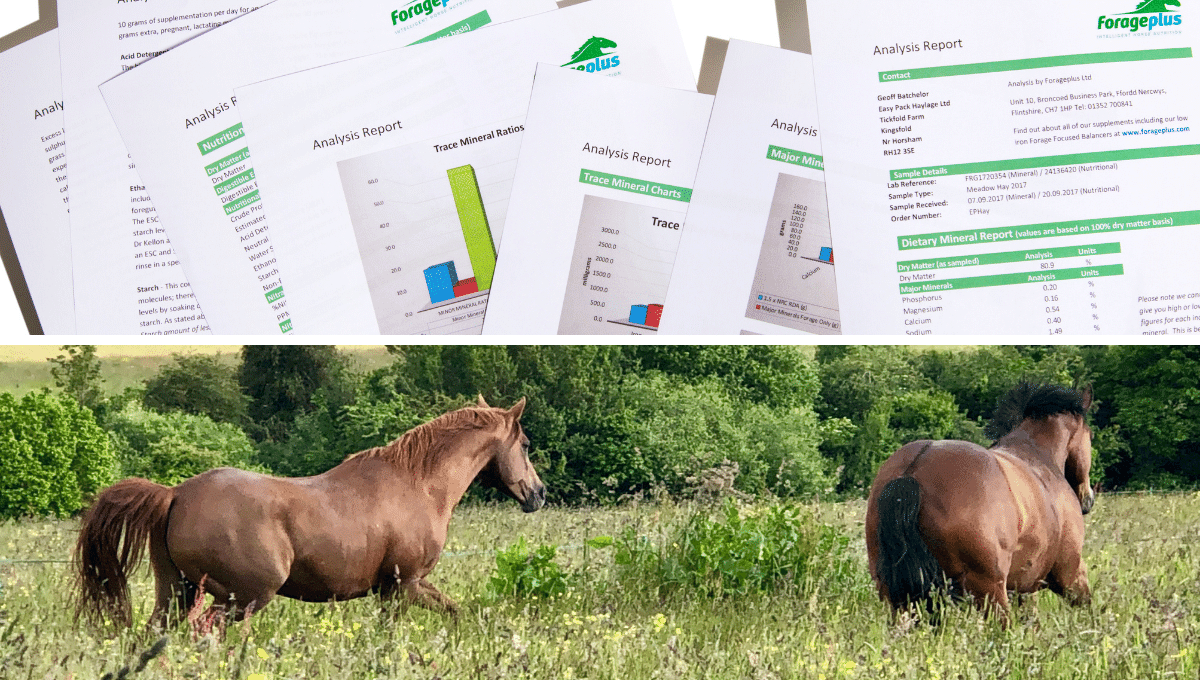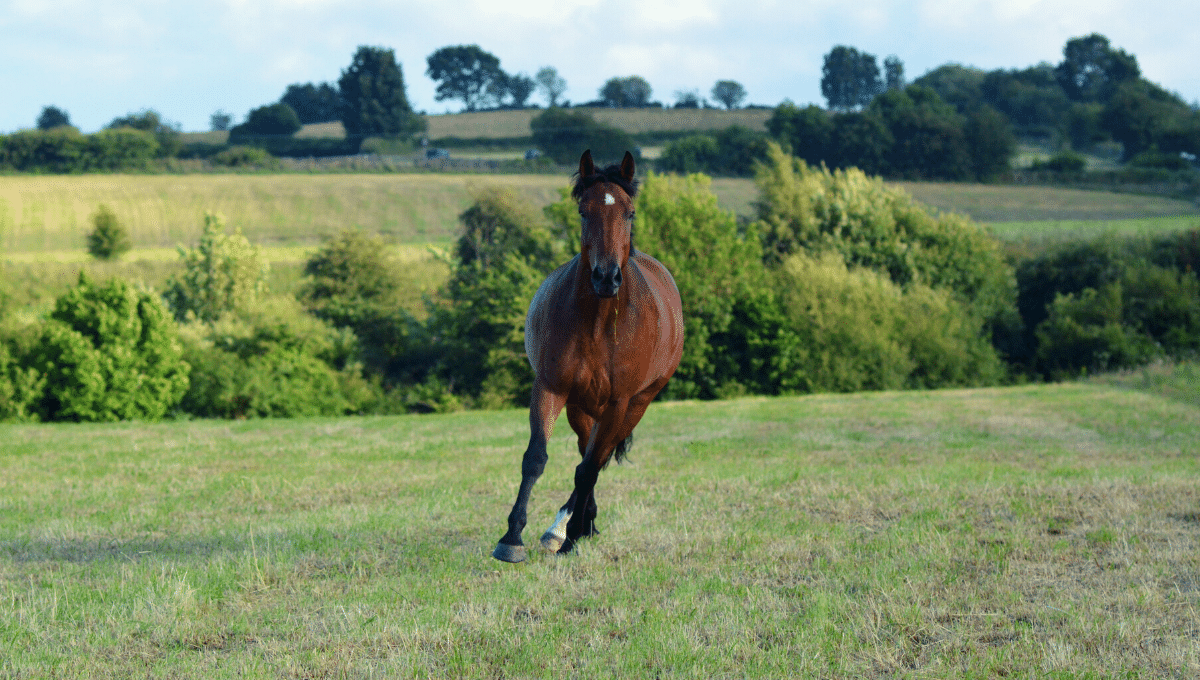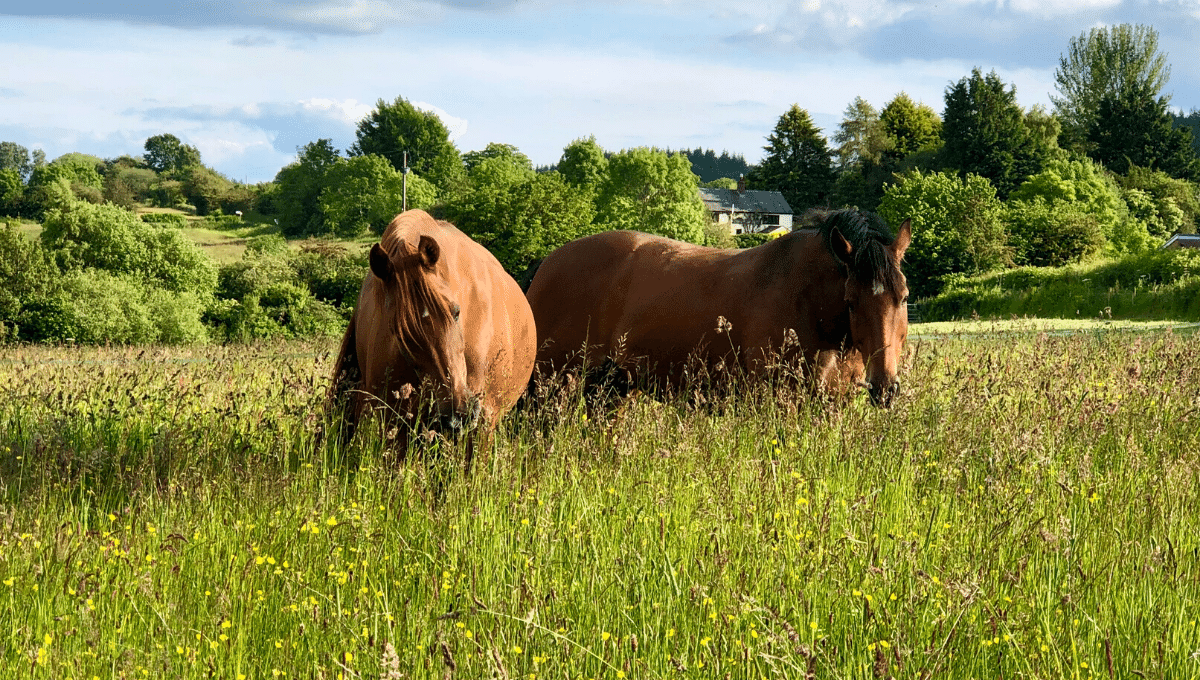Many old horses are loved members of the family. They grow old and create a lifetime of memories with us. Find powerful feeding tips in this article to make sure your old horse maintains body condition and health. Keep your equine family friend happily galloping with you for many years.
1. What happens to old horse teeth?
Perhaps the most problematic aspect of how to feed an old horse is what happens to its teeth. At the time they erupt in a young horse, a horse’s cheek teeth are approximately 4” in length (including the exposed/erupted part and the portion within the jaw). Over the years, munching grass and hay cause these teeth to wear down over time. By the time horses are in their late twenties to early thirties, most have lost the majority of their teeth. This is normal and part of the ageing process.
At around 25 years of age (sometimes before, depending upon the horse) old horse teeth will start to cause problems for many.
What changes cause problems in elderly horse teeth?
The older horse may have issues chewing even when his teeth appear to be in good shape. This is due to changes in the “Curve of Spee”. The Curve of Spee refers to the angle of chewing surfaces in the teeth of the mandible (the lower jaw). As the teeth wear, the angle changes and chewing forces become less powerful.
The classic sign of ineffective chewing is quidding – the formation of balls of partially chewed hay that are too large to be swallowed and drop out of the mouth when the horse tries to eat. However, quidding is a rather advanced sign and may not always appear to start with.
Adequate chewing is absolutely critical for exposing the interior of hays and cereals to digestive enzymes.
A reliable indication of poor chewing is an old horse that begins to lose weight despite getting adlib hay and what should be enough calories. These horses typically do much better on pasture, which is high in moisture and easier to chew, than they do on hay or haylage, so they may have particular difficulties in winter.
How does Cushing’s disease affect a horse’s teeth?
Cushing’s disease is most common in old horses and can have a strong impact on oral health. The high cortisol levels associated with poorly controlled Cushings lead to protein breakdown in muscles and connective tissues, including the small ligaments which secure the teeth in position within the bones. This breakdown leads to tooth loosening.
Cushing’s horses and elderly horses in general often have weakened immunity, especially where dietary support has not been matched carefully to grass, hay and any bucket feed being fed. Poor immunity can lead to an increased risk of gum or tooth root infections. Regular testing to keep ACTH levels in Cushing’s horses well controlled, through medication, as well as a diet high in available nutrients is vital to maintain high immune system function.
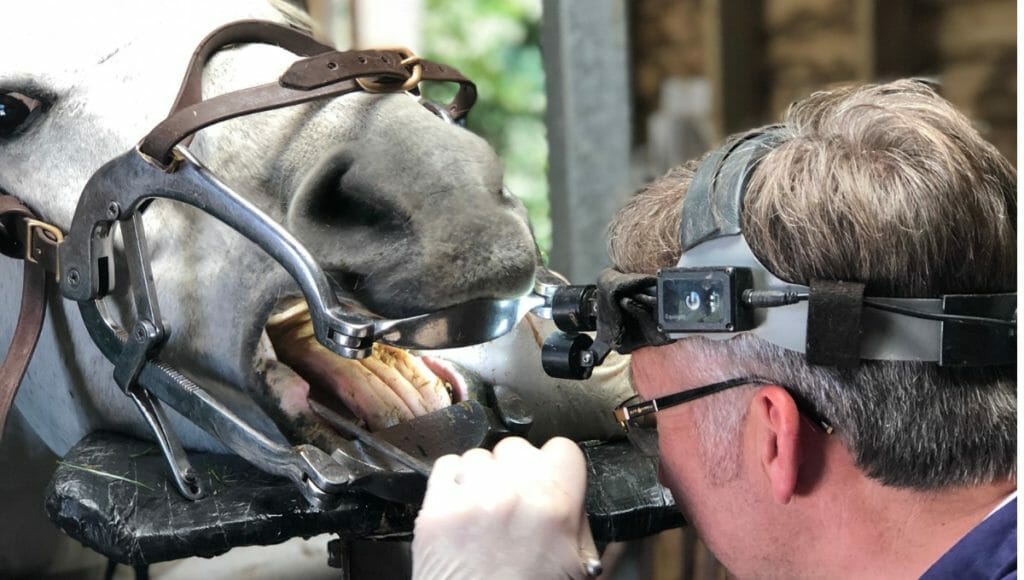
2. How does saliva production affect an old horse?
Ageing can be associated with reduced production of saliva, the normal lubricant for food. Digestion also starts in the mouth with special enzymes that are contained within the saliva, so a reduction in this means the digestive process can be compromised. Less saliva also means less buffering of stomach acid which in other species has been documented as being low in elderly animals.
3. How can stomach acid affect an old horse?
Ageing in other species of animals is known to be associated with an increased risk of low production of stomach acid. This can cause incomplete digestion of protein, failure of mineral supplements to dissolve properly and possibly overgrowth of harmful bacteria in the intestinal tract, as stomach acid provides a barrier against infections. In elderly humans, poor absorption of minerals has been linked to an increase in bone fracture.
If an old horse has unexplained poor muscling, coat or hoof issues despite having a diet balanced to hay and grass then an assumption that there is poor stomach acid is reasonable. Anaemia and poor immune system function would be among the symptoms in this situation. If no other cause is found, then using vinegar (any type, although our horses love apple cider vinegar) added to all bucket feeds containing supplemental minerals is wise. In addition, the inclusion of an essential amino acid supplement will boost the availability of these vital body-building blocks.
Essential amino acids are the smallest building blocks of protein and are ready to be absorbed without requiring any further digestion. Feeding them to an old horse makes a lot of sense if their digestion is a little compromised by age. Make sure the essential amino acid blend is dissolved in the vinegar along with the mineral supplement if possible. Then add this mixture to the bucket feed. This helps the digestive process as the pH of vinegar is around 4 to 4.5 which is very similar to the pH of a stomach which contains food.
Download this article as a free eBook
Easily share with friends and family
4. Do elderly horses have reduced digestive function?
Insufficient fermentation in the large intestine may become a problem for the older horse. Research suggests that the number and variety of protozoans greatly reduce in many elderly horses. Protozoa are important, along with vast numbers of bacterial strains for efficient fermentation.
5. What about colic in the older horse?
There are a number of factors which increase the risk of colic in an old horse.
- Cumulative parasite damage can lead to abnormal motility in the cecum, leading to more impaction problems.
- Fatty tumours called lipomas can grow to a size that then causes problems.
- Old horses are more sensitive to diet changes including different hays.
- Elderly horses often drink less. This could be due to arthritis or mouth pain, cold weather or when they are bullied by other herd members. Decreased water consumption increases the risk of impaction colic.
- Poor sodium levels in grass or hay will affect thirst. An old horse that manages to get enough liquid through eating grass can be tipped over the edge into impaction colic when cold weather reduces grass and drinking.
- Arthritis may lead to less movement. Movement is crucial to reducing the risk of impaction and gas colics.
- Use of dry chaffs especially in cold weather.
The absolute best way to avoid colic in the old horse, that you adore, is simply to understand the risk factors and try to control them where you can.
The use of chaffs can mean that old horses swallow this feed without it being ground by the teeth or having enough saliva to lubricate and start the digestion process. Chaffs are not a substitute for the crushing, mashing and mixing with saliva that normal chewing accomplishes.
Research into feeding chaffs with older horses is limited but anecdotal evidence suggests colic incidents are lowered when soaked pellets are used instead. We believe it is best to avoid chaffs in preference of a finer ground and soaked, wet forage feed, even if it’s only a precaution. The fact that you increase water consumption in the diet is a very big reason to use soaked pellets over chaff.
Be vigilant for an old horse being bullied by herd members. Keeping your elderly horse with just one, kind companion, when in a confined space is wise. If you can, monitor their water consumption, especially in cold weather. If you can’t do this then be prepared to give them a lot of soaked feed which contains a lot of water. Offering older horses warm water in cold weather is good insurance and although time-consuming, it’s always better than the heartache, and a huge hole in the bank balance, that goes with a colic incident.
6. Are parasites more of a problem in old horses?
Worms are a fact of life for all horses but thanks to modern worm counts and medicine, we can control them much better, so horses are living much longer lives. Try to carry out periodic faecal egg counts to check for effectiveness. Reduced resistance to parasite infections is commonly seen in old horses. This requires more regular deworming schedules than that of younger adult horses. If you have a really good and robust deworming programme then, that will help all horses grazing your pasture because contamination will be reduced.
Faecal egg counts and the new saliva tests for tapeworms, done before deworming with a paste, will tell you if your worming programme is working. Making sure you do these on your old horse will tell you if you have a problem with resistance. If your worm counts identify species not normally found in adult horses such as ascarids or stongyloides, then you know you have a problem with resistance.
Another option to using worming pastes is to rotate pastures and leave areas to rest ungrazed for at least 12 weeks. This won’t get rid of the need to carry out faecal egg counts or deworm but it will help break the cycle of many of the common parasites. At the same time, it means you are helping the health of the soil and pasture too.

7. What is the best daily diet for an old horse?
Once it is determined that the natural ageing process means an old horse needs a diet change, due to reduced chewing power and possibly digestive function, then a change to a soft wet diet is a must.
It is well documented in humans that ageing leads to swallowing problems. This is poorly studied in horses, but what is known is that choke is more common in the elderly horse. Poor chewing is a factor, but it may be that age-related degeneration of the throat nerves is also the reason. Ageing can also be associated with reduced production of saliva meaning food will be less well-lubricated when being swallowed.
To avoid choke we suggest opting for a range of high-fibre and high-calorie feeds that can be soaked and fed as a wet mash. This mash can be more soup-like for horses that are prone to choke.
Choices to make a feed which is wet and moist are:
Suitable for old horses without laminitis
- Unmolassed Beet Pulp (fast soak versions such as Kwik Beet or Speedi-Beet are convenient)
- Grass Pellets (Dengie and Emerald Green make good ones)
- Hay Pellets (Simple Systems and Thunderbrook Equestrian make excellent products)
- Alfalfa Pellets (take care with this feed, see the bottom of this article)
- Micronised Linseed (helps the slime factor and adds omega 3 essential fat)
- Wheat Bran (provides high calories and works well with hay and grass pellets, and beet pulp due to the phosphorous content)
- Coolstance Copra (high calories, medium chain triglyceride fats make this a great choice to also extend protein sources)
- Rolled or Flaked Porridge Oats (works well with hay/grass pellets and beet pulp for the concentrated energy and high phosphorus to balance calcium)
- Forage-focused horse feed balancer matched to statistical analysis of grass and hay
Suitable for old horses with or prone to laminitis
- Unmolassed Beet Pulp
- Grass Pellets
- Micronised Linseed
- Forage-focused horse feed balancer
Horses vary in how wet they like their soaked feeds. Some like them just moist enough to barely crumble, while others will eat/drink their feed in soup consistency. As a general rule, the more water the better. This makes the feed similar to pasture, improves digestibility, helps protect against choking and keeps an old horse well-hydrated. Good hydration stops food from moving slowly in the guts and reduces the risk of spasmodic or impaction colic.
How long will it take to soak old horse feed?
Follow the manufacturers’ guidelines when soaking any of the high-fibre fast-soak horse feeds. In general cold water will take much longer than hot water. If using cold water an overnight soak may be needed. If using hot water the soak may only take 15 to 30 minutes.
Using a gas-powered hot water system is a useful way to speed up the soaking time for large bucket feeds. These hot water systems can easily be installed in stables and barns and some are even portable.
The tighter the feed pellet then the longer the soak time will be needed. Use your eyes and perhaps your fingers to feel if the products have soaked enough. Always use a large volume of water.
Weight in kilograms of old horse feed (Stubbs Scoop)
This table gives approximate weights of the separates we suggest using with old horses. This will help you judge how much you are feeding. It is, however, always best to use electronic kitchen scales to weigh scoop amounts to check accuracy.
| Straight Horse Feed | Stubbs Scoop | Approximate Weight |
|---|---|---|
| Grass Pellets | 1 | 1.5 kilograms |
| Hay Pellets | 1 | 1.5 kilograms * |
| Unmolassed Beetpulp (SpeediBeet) | 1 | 1 kilogram * |
| Flaked Porridge Oats | 3/4 | 500 grams |
| Rolled Oats | 1 | 1 kilogram |
| Wheat Bran | 1 | 500 grams |
| Copra | 1 | 1 kilogram |
| Micronised Linseed | 1/2 | 500 grams |
* The weight in a Stubbs scoop should be checked as some pellets may weigh more or less than others.
How much of each separate feed should I use with my older horse?
The answer is it depends. Feeding horses is as much an art as a science and the best owners will pay great attention to how their horse is looking and feeling each and every day. In winter make sure you remove rugs regularly to monitor body condition. A good practice is to take a quick side-on photo each month to keep a record of how your elderly horse is looking.
There are lots of different scenarios which will change the amount of bucket feed your older horse needs. These can be:
- Amount of hay or grass eaten
- Weather temperature
- Exercise level
- Time of year and hours of access to grazing
- Dental health
- Body condition score
How much hay or grass will an old horse eat?
In general, the older a horse becomes the more difficult weight management becomes so it is good to give them access to ad-lib hay or soaked hay replacement bucket feed. If the horse is not laminitic or prone to laminitis, then access to grass should be encouraged. Ideally, the grass should be long enough to provide clean grazing, but leafy enough to be easily chewed and digested by an elderly horse. Grass between six to eight inches long is perfect.
If a horse is prone to laminitis then access to grass should be carefully controlled. Many laminitis-prone horses do well on late, leafy autumn and winter grass, but as spring and early summer arrive, the simple sugars in the grass fluctuate and high levels can trigger both low-level and full-blown laminitis. In this respect, it is best to either strictly control grass access to the early morning only or remove the horse from all grass onto a turn-out area which allows for movement.
The amount of hay an old horse eats can be deceptive as if they quid a lot, then much of what they chew actually ends up on the floor. Allowing old horses to continue to exercise the drive to select forage and chew is very important but owners need to understand that the horse may be consuming very small amounts of hay. In this instance then, consideration should be given to feeding a high partial replacement, or even a total replacement bucket feed.
In the end, owners need to be guided by their horse, pay attention to body weight and treat each old horse as an individual.
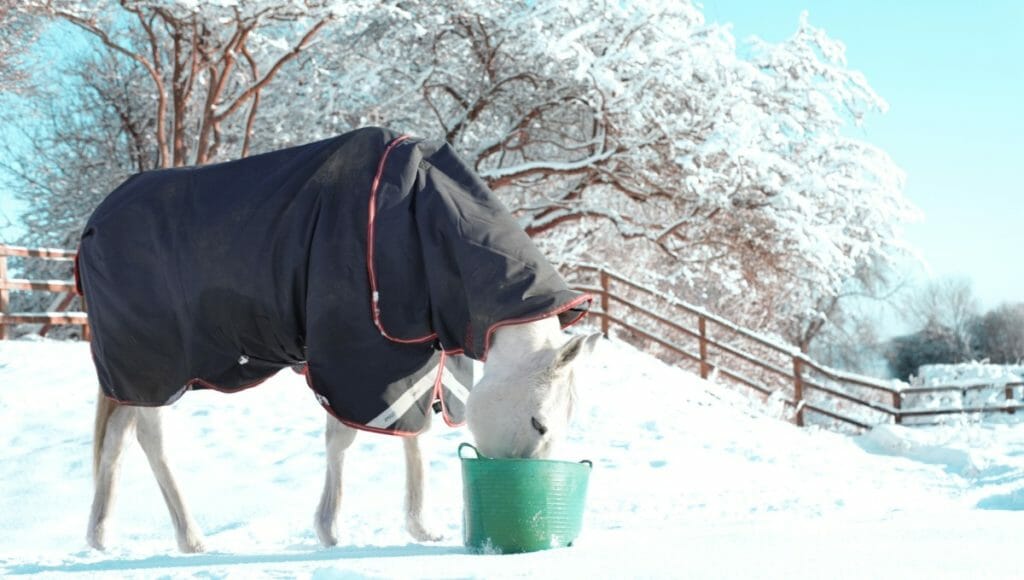
How does weather temperature affect feeding elderly horses?
The calories needed are directly related to how warm or cold your horse is. So when it’s toasty outside, and you are in your t-shirt, then your horse will need fewer calories than when you are in your thermals and duvet jacket.
In the depths of winter, an older horse may need a lot of calories to keep warm and maintain body weight. Often a poor doer, old horse, will also need to wear a very warm rug. If you buy one with a detachable neck cover and pair it with liners, then you can protect your horse according to the temperature, at the same time as increasing the amount of bucket feed, if needed.
Using high-fibre feeds like grass and hay pellets, and beet pulp, means that the digestive system will act like a central heating system from within your horse. Remember too that if snow covers grass then an old horse with poor teeth will not be able to get additional calories from hay or haylage like a younger horse. This means you have to up the high-fibre portion of the bucket feed to compensate for less grass availability.
How exercise affects feeding old horses
All horses who are in work will need higher levels of minerals, vitamins, protein and calories in their daily diet. Feeding older horses should really be no different. Where an old horse may struggle is if they have compromised teeth or digestion as discussed above. In this scenario increasing the amount of bucket feed is necessary.
How the time of year and access to grazing affects feeding older horses
If an old horse is not prone not laminitis or is a very good doer, then using lots of time eating grass will be an easy way to feed them. Leafy grass is softer and easier to chew than hay or haylage so many older horses maintain their weight more easily on spring and summer grass.
When winter sets in and the grass content lowers in the total diet then this is where many horses lose weight even though they look as if they are still grazing and eating enough hay or haylage. The months of December through March seem to be the worst, as grass availability is poor and the weather often turns a lot colder. It is very wise to assume that an old horse will lose weight if you don’t substitute quite a high proportion of hay and haylage with soaked high-fibre feed.
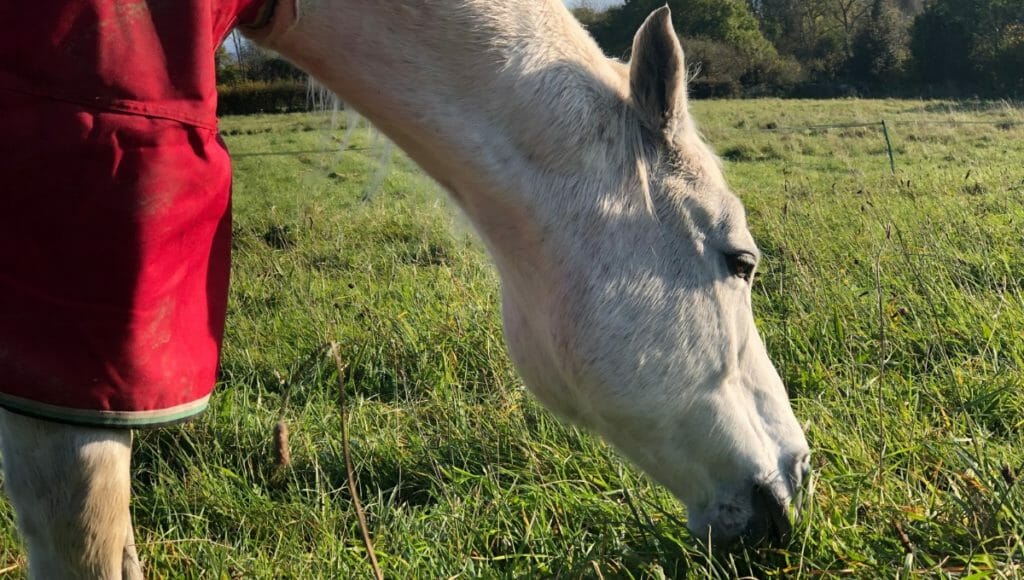
How dental health affects feeding elderly horses
We covered the whys of dental health affecting older horses at the start of this article. A basic rule is that as a horse progresses into their mid to late twenties the power of the teeth’s grinding capabilities will reduce.
Substituting a proportion of the hay or haylage fed with a high fibre-soaked bucket feed BEFORE weight loss starts is very wise. How much is needed depends upon the age of the horse, their exercise level and the wear state of their teeth.
The truth is that horses that get enough balanced calories, protein, minerals, vitamins and Omega 3 fat in their daily diets, will maintain muscle mass, weight and health the best. Being proactive rather than reactive is best for longevity. Awareness that your elderly horse will need feeding support, due to dental ageing, will always be a good approach.
8. How much soaked bucket feed to feed an old horse?
No matter how much extra bucket feed your horse gets, great attention should always be paid to carefully balancing the major and trace minerals, calculating energy/calorie levels for a healthy weight, and checking enough protein is supplied.
The following tables are combinations of suggestions that can be used as part or total replacement of hay and grass for a 450 – 550 kilogram horse. Note that table one is suitable for horses that are not prone to laminitis. There are fewer options for horses prone to laminitis because it is essential to keep the combined levels of starch and simple sugars under 10% in the total diet.
Why do we recommend the use of straights for old horses?
Suggestions are chosen from straights to help supply:
- varied protein sources
- balance major minerals
- limit fillers and unnecessary additives
- sufficient calories
- eliminate molasses in the diet
- be more cost-effective for the owner
- create an effective fast soak bucket feed
There are many old horse or veteran complete horse feeds on the market, but they often contain bulk fillers such as oat and wheat feed in high amounts, which are not necessary in the diet of horses. In addition, most of these feeds supply high amounts of molasses which is not desirable in large amounts when substituting hay for an old horse. We believe the smart horse owner buys the separate single feeds and mixes them so that the horse has the best chance of health.
It is very important to understand the daily feed should always be supplemented with a forage-focused mineral and vitamin balancer which is high in minerals which are commonly deficient in a forage focused diet. This should be fed throughout the year to all horses as grass is also deficient in the same minerals as hay.
All bucket feeds tend to be high in calcium, where high amounts of grass pellets, hay pellets and beet pulp are used. This is why, for old horses who are not laminitic, we suggest combining these feeds with high-phosphorous feeds such as oats, linseed, copra and wheat bran. The amounts balance the calcium and phosphorus more adequately, and then the forage focused horse feed balancer tops up phosphorous, magnesium and the other trace minerals needed.
Amounts are total daily weight. They are based on a 450 -550 kilogram horse eating around 10 kg of hay or haylage (2% of body weight) and can be split into two, three or four feeds per day. We have given low and high hay replacement figures as well as total replacement amounts. This will allow maximum flexibility.
Contact us if you would like us to formulate amounts based on your horse’s body weight. These carefully calculated choices and amounts are intended to be a guide to help you understand how to take control of your elderly horse’s diet.
Best feed choices: Old horse NOT prone to laminitis
| Weight of Hay Replaced | Feed for Low Partial Replacement | Feed for High Partial Replacement | Feed for Total Replacement | |
|---|---|---|---|---|
| Grass Nuts | 1kg | 1 Kg | 1.5 Kg | 2 Kg |
| Hay Nuts | 1kg | 1 kg | 1.5 kg | 2 Kg |
| Unmolassed Beetpulp | 1.5kg | 1 kg | 1.5 Kg | 2 Kg |
| Rolled or Flaked Porridge Oats | 1.5kg | 100 grams | 300 grams | 500 grams |
| Wheat Bran | 2kg | 100 grams | 300 grams | 500 grams |
| Copra | 2kg | 100g grams | 300 grams | 500 grams |
| Micronised Linseed | 3kg | 100 grams | 200 grams | 300 grams |
Best mineral & vitamin supplementation: Old horse NOT prone to laminitis
| Product | Supplements to Balance Low Partial Replacement | Supplements to Balance High Partial Replacement | Supplements to Balance Total Replacement |
|---|---|---|---|
| Best Forage Focused Balancer | 100 grams per day Hoof & Skin Health Balancer Winter | 100 grams per day Hoof & Skin Health Balancer Winter | 100 grams per day No Selenium Balancer |
| Extra Supplementation for Optimum Balance | None Needed | None Needed | 1 x 2.5 ml scoop per day Bioplex Manganese |
| Electrolytes to Cover Sweat Losses Due to Weather or Exercise | *40 grams of salt per one hour of continuous sweating | *40 grams grams of salt per one hour of continuous sweating | *40 grams of salt per one hour of continuous sweating |
* Salt can be fed as table, rock or sea salt. In addition, a white salt block should always be available for horses to use if needed.
Best feed choices for an old horse PRONE to laminitis
There are fewer feed choices available for an old horse prone to laminitis. This is because extreme care should be taken to keep starch and simple sugars under a total combined amount of 10%. This will keep insulin levels low and stable. It is high, peaking insulin which has been shown to be a trigger for laminitis events in horses.
Although some laminitis-prone horses will tolerate Copra, the starch level in Copra is sometimes too high for it to be a good choice for all laminitis-prone horses. Where an elderly horse has well-controlled insulin levels, then Copra can be used, but care must be taken with this feed.
Oats are generally to be avoided with laminitis-prone horses. An exception to this is where good insulin control has been achieved and the horse is in regular exercise. In this situation, 100 grams of Flaked Porridge Oats can be fed in a small bucket feed, with 100 grams of unmolassed beet pulp, immediately following an exercise period.
| Product | Weight of Hay Replaced | Feed for Low Partial Replacement | Feed for High Partial Replacement | Feed for Total Replacement |
|---|---|---|---|---|
| Hay Nuts | 1kg | 2 kg | 3.5 kg | 5.5 kg |
| Unmolassed Beetpulp | 1.5kg | 1 kg | 2 kg | 3 kg |
| Micronised Linseed | 3kg | 100g | 300 grams | 500 grams |
Best mineral & vitamin supplementation: Old horse PRONE to laminitis
| Product | Supplements to Feed for Low Partial Replacement | Supplements to Feed for High Partial Replacement | Supplements to Feed for Total Replacement |
|---|---|---|---|
| Best Forage Focused Balancer | 150 grams per day Laminae Plus Balancer | 150 grams per day Laminae Plus Balancer | 150 grams per day Laminae Plus Balancer |
| Extra Supplementation for Optimum Balance | None Needed | None Needed | 1 x 2.5 ml scoop per day Bioplex Manganese |
| Electrolytes to Cover Sweat Losses Due to Weather or Exercise | *40 grams of salt per one hour of continuous sweating | *40 grams of salt per one hour of continuous sweating | *40 grams of salt per one hour of continuous sweating |
*Salt can be fed as table, rock or sea salt. In addition, a white salt block should always be available for horses to use if needed.
Why do we not list alfalfa as one of the separates for an old horse?
Alfalfa is an excellent feed for horses and can be chosen to feed an old horse, but its high calcium levels mean that it causes problems with balancing the major minerals. In addition, some horses do not tolerate alfalfa in their diet. Problems can range from worsening hoof sensitivity and laminitis, skin hives, to oedema in the legs, sheath and udder. There is little research to suggest why this is.
If your horse likes and tolerates alfalfa then feeding up to 1 kg per day is possible in place of 1 kg of grass nuts. Dengie do a good alfalfa pellet.
Dengie also do a product called Alfabeet which is alfalfa and unmollased sugar beet combined in one bag. You could substitute grass pellets and separate beet pulp with this product as long as you don’t feed more than a total of 1 kg of alfalfa per day.
9. Should you test the hay and grass your old horse is eating?
The decision to carry out scientific analysis on the grass and hay an elderly horse eats, depends largely on whether you have control over the forage eaten and the amount eaten each day.
Where an elderly horse is on a low partial replacement bucket feed then, testing hay to check mineral, protein and calorie levels can be an important tool in determining the best daily nutrition.
Where an elderly horse is consuming a high amount of grass then scientific testing of the minerals will allow correct balancing of the daily diet so that ratios of both major and trace minerals are optimal for long-term health.
Where you can test neither hay nor grass then our suggestions can be followed as they have been calculated using analysis of each feed suggested and a low statistical average of the nutritional figures we see in the hundreds of samples we carry out each year. This is unique data stretching back more than ten years, and we are experts in this area.
What about soaking horse hay?
The decision to soak hay should be made on the health of the horse. An old horse with COPD may need hay soaking or steaming for a very short time. A laminitic horse may need hay rinsing and soaking for a short time to lower the simple sugars in the hay to prevent insulin levels from spiking.
In general, we would always encourage owners to avoid soaking hay if possible. Where a horse has COPD then spraying and damping the hay should be sufficient. The latest research into steaming hay suggests that protein quality may be affected, so if steaming is carried out, additional protein may be required to compensate for this.
Where hay is soaked to lower simple sugars for an old horse who is laminitic, then it is always wise to check the level of simple sugars and starch in the hay. Many hays do not need to be soaked and testing will allow you to confirm this and have peace of mind.
If you can’t test, then understanding the effect soaking has on hay and choosing to soak for short periods of time, will preserve the nutrient status of the hay. It is important to use a protocol which will not leach high levels of water-soluble nutrients from the hay.
Our research into the effect soaking has on hay has revealed that high amounts of water-soluble nutrients, which are critical for horse health and hard to replace, are washed down the drain.

10. Protecting an old horse in the herd
The final consideration is to make sure the horse has sufficient time to consume his meals, in an environment where he will be protected from other horses. If a total replacement diet is needed then an area to munch, for an hour or two, in peace will be needed. This could be in a stable or in a fenced-off area. Although difficult to manage, this is the only way that a horse, which needs a considerable percentage of its diet as a soaked feed, will be able to consume enough food to maintain weight and health.
As they age, horses tend to fall to lower positions of status within the herd. Research carried out on Icelandic horses indicated that rank in the herd could affect horse’s food availability considerably.
You have to protect your chewing-challenged old horse from competition and bucket stealing. If you can set up a management system to accommodate this and provide a diet he/she can digest well, supply optimum protein, sufficient calories, omega 3 fat and balanced minerals and vitamins, then he/she will thrive and gallop into the future for as long as is possible.
Contact us if you would like us to formulate amounts based on your horse’s body weight. These carefully calculated choices and amounts are intended to be a guide to help you understand how to take control of your elderly horse’s diet.



